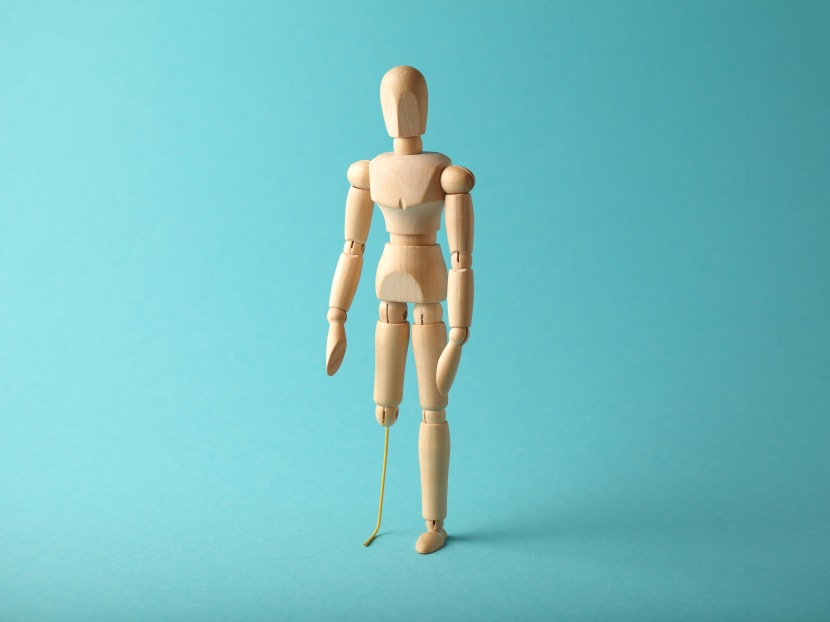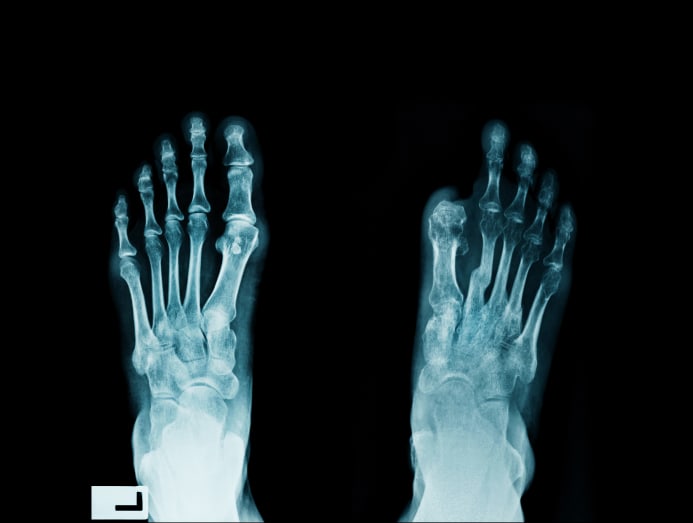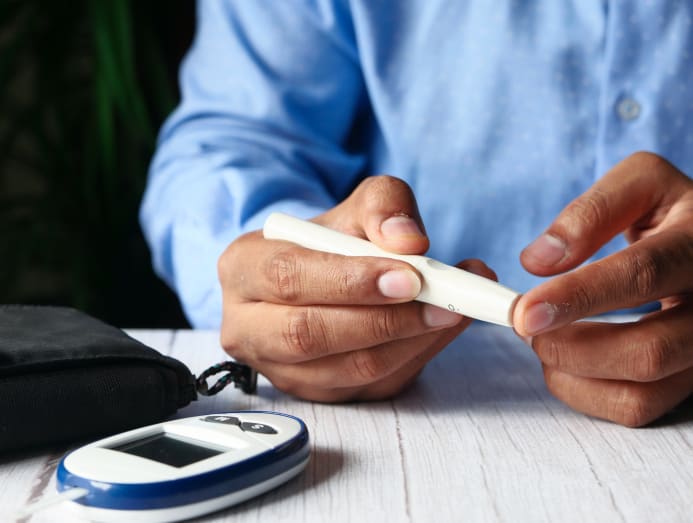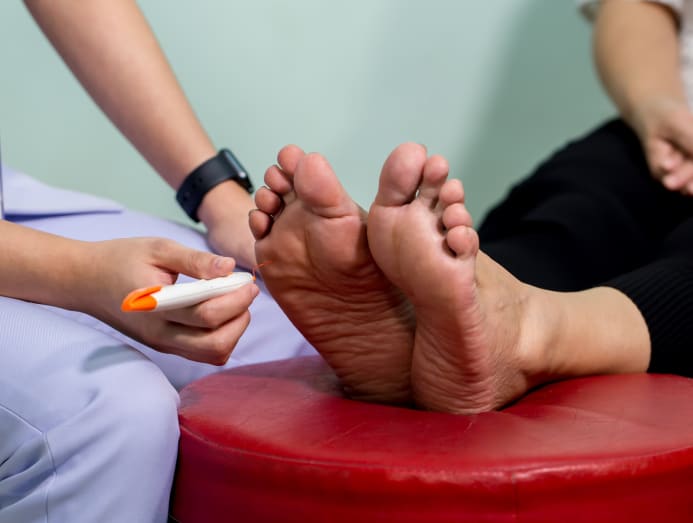Why limb amputation is the dark side of diabetes many people don’t consider
Advertisement
Wellness
Why limb amputation is the dark side of diabetes many people don't consider
13 per cent of diabetic patients below the historic period of 50 were constitute to have developed complications that could crave amputation, according to a local written report.

(Photo: iStock/Andrii Zastrozhnov)
08 Sep 2022 07:11AM (Updated: 08 Sep 2022 11:47AM)
When it comes to diabetes, virtually people would know that managing the affliction involves diet restrictions and insulin shots.
Not many, though, would recollect of something every bit desperate equally limb amputation as beingness a office of the equation.
Still, the grim procedure required to treat diabetes-related lower extremity complications or DRLEC is institute to be high amongst Singaporeans, according to research by National University of Singapore'due south Saw Swee Hock School of Public Wellness (SSHSPH).
The written report, based on data on more than 156,500 patients with Blazon 2 diabetes between 2007 and 2017, found that xx,744 patients developed DRLEC.
Of this group, one,208 eventually underwent limb amputation. The findings were published in the July result of Diabetologia.

Information technology's not simply elderly grandfathers (men accept a higher incidence than women) who were likely to develop DRLEC; 13 per cent of diabetics who developed the complications were below age 50, said SSHSPH'southward Associate Professor Kavita Venkataraman, citing the study'south findings.
In fact, for patients below historic period 50, Assoc Prof Venkataraman said that the time it took for diabetes to progress to DRLEC is about 27 months. This is shorter than the average of about 31 months seen in older patients.
In patients under age fifty, it was most nine months on average betwixt the onset of DRLEC to amputation, according to the study. In older patients, the average duration is shortened to nigh 2 months.
Furthermore, ane quarter of those who underwent amputation already had DRLEC at their beginning diabetes consultation.
WHY THE FUSS?
The findings underscored what the government highlighted: The lack of sensation and control of diabetes. The latest statistics in 2022 showed that 400,000 live with the disease in Singapore.
Of these, one in three is non aware that he or she has it. Those who are aware of their condition, ane in 3 has poor control over it.
And we oasis't even considered those who are pre-diabetic, which co-ordinate to this study, an estimated 430,000 Singaporeans aged eighteen to nineteen are.
Pre-diabetes is a state where the blood saccharide levels are college than normal but not loftier enough to be diagnosed equally diabetes.
If left unchecked, nearly one 1000000 people in Singapore will accept diabetes past 2050 – and past extension, a potential rise in DRLEC.

Limb loss aside, it too hurts the patient'southward pocket when it comes to managing DRLEC.
The amount is "healthcare system-dependent" here, said Associate Professor Andrew Choong, a consultant with the Section of Cardiac, Thoracic and Vascular Surgery at National Academy Center Centre, Singapore.
A foot or leg amputation tin price betwixt US$30,000 (Due south$40,670) and US$60,000 in initial hospital costs, he said, citing the Journal Of The American Podiatric Medical Clan.
Then, it's another US$43,000 to United states of america$sixty,000 for follow-up care over the next 3 years.
"This is a huge bear on to whatever healthcare organisation," he said.
HOW Practice YOU TELL IF YOU Have DRLEC?
DRLEC may be missed because many patients may non take any symptoms, said Assoc Prof Venkataraman. The initial signs may include:
- reduced sensation in the toes and feet;
- numbness or sensations of tingling or pins and needles;
- pain in the feet;
- pain in the calves, thighs or buttocks when walking and goes away when they stop.
The numbness or hurting is more likely to occur in the toes and feet equally the "nerve damage due to diabetes is length dependent", she explained. So, the "longer the nervus, the more likely information technology will get affected".

Some other factor that leads to DRLEC is the reduced sensation in the feet due to the nervus impairment.
These patients are likely to become small cuts or injuries on the toes or anxiety without realising it, said Assoc Prof Venkataraman.
"When they also accept poorer blood menstruation, such cuts and ulcers will not heal easily, and they may get infected."
WHAT Can CONTRIBUTE TO DRLEC?
The risk factors for DRLEC include having other chronic atmospheric condition at the fourth dimension of diabetes diagnosis, poor control of diabetes, a high trunk mass index, smoking and age, said Assoc Prof Venkataraman.
Smoking, for example, contributes to DRLEC by damaging the claret vessels in the lower limbs, she said.
A greater propensity for smoking bated, men are also predisposed to DRLEC by virtue of their hormones.
Assoc Prof Venkataraman said that some studies suggest men may lack the hormonal factors that protect women from nervus and blood vessel impairment in the lower limbs.
Equally for historic period, growing older can stiffen claret vessels and render them less elastic. "This affects the amount of blood flow and increases the risk of other damage to these vessels," she said.

Assoc Prof Choong added that it is important for diabetics to "undergo regular foot screening and surveillance as part of their handling".
"Closed-toe, well-fitting shoes are a must and daily foot checks are encouraged," he said.
DOES DRLEC Always End WITH AMPUTATION?
Thankfully, not every example of DRLEC will crave the process, said Assoc Prof Venkataraman.
In full general, amputation is simply required when the ulcer is not healing well, there is a take a chance of the infection spreading to the rest of the body, or if the affected toe or human foot area is dying due to the lack of blood supply, she said.
In fact, amputation should not exist taken lightly, said Assoc Prof Choong. "The amputation of a limb, in nigh cases, is a bereavement.
"There is often a pregnant grief reaction associated which can lead to feet, depression and guilt. This is oftentimes amplified when our patients meet their amputated limb or when they realise that they have lost function and cannot resume the activities they used to practise."
Assoc Prof Choong said that generally, the higher the amputation and the more joints lost, the harder it is for patients to return to their pre-amputation part.
"Information technology is very patient dependent. In that location are some patients who are unable to recover their full part and worry that they become a brunt to their caregivers and families.
"Every bit such, prevention and early on surveillance are far better than having to manage limb amputation in the first identify," he said.
Contempo Searches
Trending Topics
Source: https://cnalifestyle.channelnewsasia.com/wellness/diabetes-limb-amputation-singapore-278591

0 Response to "Why limb amputation is the dark side of diabetes many people don’t consider"
Post a Comment